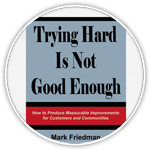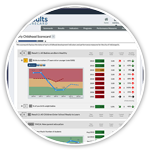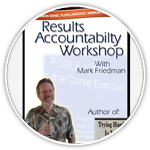A Different Organization Chart for State Local Partnerships to Improve Outcomes for Children and Families
What does outcome-based decision making have to tell us about how we organize the way we work together? The way we structure our organizations, and their working relationships with each other, have a lot to do with both what work gets done and how it gets done. This is part of the reason why we seem to have an obsession with reorganization. We figure that if the work isn’t getting done well, maybe a different configuration will solve our problems. Problem is, there are limits to what organizational change, by itself, can do about problems of performance. But that’s another story.
Let’s take a look at what the organization chart would look like if the dominant concern was about outcomes – defined as the condition of well-being of children, families and communities. Needless to say, it would look somewhat different.
First of all, since outcomes, by definition, cross over program and agency boundaries (e.g. no single organization entity is responsible for “children ready for school” or “children staying out of trouble”) then we need structures which cross over agency boundaries. Now we have plenty of these, but they don’t necessarily have anything to do with outcomes.
We might end up with something like the chart on the next page. This chart shows the structure of working relationships of an outcome-based organizational structure, at the state and local level and the interrelationship of each. Let’s take a quick tour.
First we find that there are state and local teams each devoted to a particular outcome (denoted by the capital letters A through G). Each of these teams has a charge to “turn the curve” on the indicators of the outcome in question. The state and local team together make up a “turn the curve partnership.” Together they have separate perspectives on the outcome and indicators, separate spheres of control and influence in the work of turning the curve. The teams help each other make a difference at the local and state levels respectively. (The state team might clear hurdles – bust barriers – for the local team. The local team might help demonstrate ways to turn the curve in a particular community that could be used statewide. etc.)
Notice that there is not a perfect alignment of outcomes between the state and local levels. Outcome A is a state-only outcome. Outcome G is a local only outcome. Outcomes B through F are shared. This reflects the use of common outcomes across jurisdictions (B – F), with allowance for local jurisdictions to add to or modify outcome statements to reflect local conditions and priorities (G).
At each level, there is a need for the work of the individual outcome teams to bring their work together into some coherent whole. The “common ground” committees are the places where this happens. It will be quite natural for the strategies crafted by separate outcome teams to have a lot in common. (Family centers, for example, might show up in the strategies of several teams.) The common ground committees are where these separate strands are brought together into a single strategy. The common ground is a place for leadership, both literal and figurative. This is the place where there can be a sense of shared accountability for the well-being of children and families across the community. The leaders of the state and local common ground committees form a natural leadership partnership which spans the state, and which can advance this work in decision making forums at both levels.
At both the state and local levels, there are a range of functions which must be carried out well in order for the work of improving outcomes to proceed. These functions have to do withcommunications (both public and inter-organizational), data (the development of baselines and forecasts and timely, quality data on indicators), budget (the use of the what works strategies of the turn the curve partnerships in crafting multi-year budgets), what works (the support of the research community and others in harvesting the best information we have on effective approaches to turning the curves on child, family and community well-being), systems configuration (the work of figuring out how the pieces of the common ground strategy fit together and how formal and informal service systems can be made to support the work of improving outcomes), and capacity building and training (the work of helping people understand and do this hard work).
The membership of the various groups within this organizational structure goes beyond government to include the business community, the private sector, parents and citizens, and indeed anyone with something to contribute to the work. How these groups are structured is the subject a range of papers on the subject of “governance.” And how these groups do the work of turning the curve is the subject of papers on “outcome based decision making and budgeting.” We will not repeat that here. See the reading list in the footnotes and at the end.
It is important to note, however, that this view of state and local organization does not replace the current organization of government by function or type of service. It is, at least at first, an overlay which allows government to participate in the work of improving outcomes across departmental and community boundaries. This work is very much about the participating government and private sector organizations meeting their core missions. Education folks participate because having partners help turn the curve on “children ready for school” or “children succeeding in school” helps meet the core mission of the education system. Health folks participate because having partners help turn the curve on “healthy children and adults” helps meet the core mission of the health department. Social service folks participate because having partners help turn the curve on “stable and self sufficient families” helps meet their core mission.
This view of a “different organization chart” can not and should not be implemented all at once. It may be that it starts with just one team at the local level trying to turn one curve on one indicator of one outcome. But it sometimes helps to see where this work fits into a larger whole, and how it might evolve to become a different way of doing business on a larger scale.



